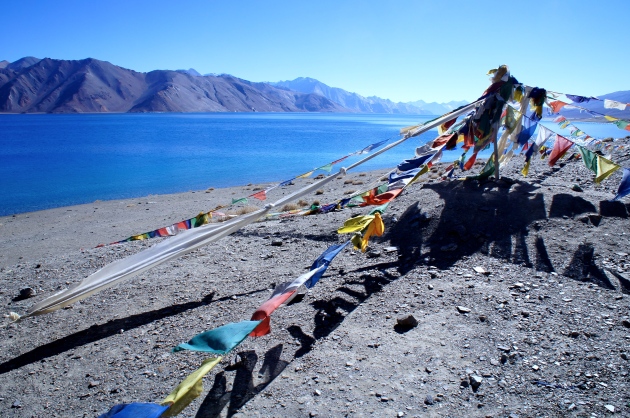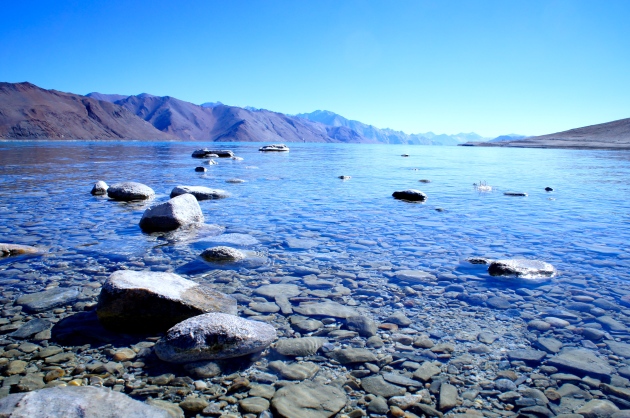There’s one more special place I would like to share with you. I call this place the sparkling jewel of Ladakh.
But first, let me set the scene.
It was cold. Mainly because we woke up to leave for Pangong Lake at 6am. It was also dark at first, but the journey ahead was long so we all agreed it was good to set off early.
The roads were winding and bumpy. We had to ascend to Changla Pass and get to the other side of it. Thereafter, it was miles and miles of brown, semi-frozen landscape. All in all, the journey wasn’t as comfortable as we expected it to be because of the cold-bumpy combination. The journey would take about 5 hours, the driver had said, so we braced ourselves to tahan (Malay word meaning to endure) for that duration.
After what seemed like eternity, the driver stopped the car and pointed into the distance. There, peeking out between two mountain slopes, was a little triangle of bright blue, like a piece of sapphire glimmering against the dull dry stony grey-brown land. A signboard informed us that this sighting was ‘The first view of Pangong Lake’. I felt that way you feel when you sense a glimmer of hope in a dire situation.
Pangong Lake came into full view shortly. It was mesmerising. We had wondered to ourselves whether the lake would be frozen as it was situated at about 14,000 feet above sea level. Plus, we had already witnessed frozen streams and ponds along the way.
Thankfully, only the edges of the lake were frozen, and it was for the most part still it’s beautiful blue self.

Photo credit: Juxxtapose
It was still cold but we were excited enough to be distracted from that now. The place was almost secluded, save a restaurant that was still open. I think the guesthouse there was already closed for the winter. This meant we had the place to ourselves. We took a ton of photos, skipped rocks over the surface of the lake, spied on where Tibet was on the opposite end of the lake, and basically felt comfortable being our silly selves.
If you get too engrossed in the beauty of it all, you might think you were in New Zealand. Until you see these colourful flags – a little reminder of where you actually are.

Photo credit: Juxxtapose
The driver pointed Tibet out for us – the furthest, bluest mountain in the picture below. The waters, as you can see, were crystal clear, possibly the clearest, most sparkling I’ve seen.

Photo credit: Juxxtapose
When we finally dragged ourselves away and returned to the car, we saw that a few cars had arrived. Our early arrival had meant that we missed even the little crowd that would be there during this off-peak season. Was it worth the early start, the extra cold because of the early start, and the long journey? I asked the hubs on our way back. Yes, he said. I agreed.







 The first thing we learnt about Leh is that the weather forecast doesn’t seem accurate. The day before we flew there, we checked the temperature again on iOS and google, and it said 26 degree celsius. Right, I’m sure it is.
The first thing we learnt about Leh is that the weather forecast doesn’t seem accurate. The day before we flew there, we checked the temperature again on iOS and google, and it said 26 degree celsius. Right, I’m sure it is.


